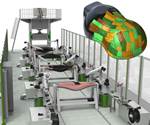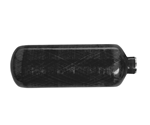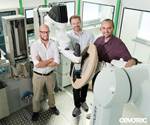Cevotec scales up Fiber Patch Placement technology for large aerostructures
The SAMBA Step L automated fiber placement system can place patches of material up to 50 times larger than previous FPP systems.

Source | Cevotec
Automation specialist Cevotec (Munich, Germany), known for its Fiber Patch Placement (FPP) technology, has announced advancements in FPP to meet aerospace industry demands for complex and large aerostructures. The SAMBA Step L is the largest member of Cevotec’s SAMBA series to date, and can reportedly handle a maximum patch size of 200 millimeters by 300 millimeters, a scaling of 50 times compared to the initial 20-millimeter by 60-millimeter patch area. According to Cevotec, the new technology will widely expand the range of components processable by Fiber Patch Placement technology, with the primary goal of serving the aerospace industry’s application and process development requirements.
The SAMBA Step L is set up in the company’s cevoLab near Munich, Germany, and will be operational for customers this spring. The system features a 6-axis pick-&-place robot mounted on a linear axis.
“The increased range of the robot allows us to deal with specific part sizes of common aircraft components,” says Dr. Neven Majic, executive VP of Cevotec.“Adapted to the specific component sizes, we also scaled the patch grippers to process patches up to DIN-A4 size (approx. 200 millimeters by 300 millimeters).”
To enable maximum flexibility in the development process, predefined patches of different sizes and materials can be fed individually to designated pick-up positions. A smooth deposition of large patches on curved surfaces is realized by a special roll-placement feature. This new patch deposition strategy is said to contribute significantly to the quality of large patch laminates and to effectively prevent laminate air enclosures.
SAMBA Step L is designed for developing automated lay-up processes for large aerostructures, such as spatially curved sandwich structures, with sizes of up to 2 meters by 3 meters, and including materials like carbon, glass and aramid fibers, adhesives and more. Like other SAMBA systems, SAMBA Step L features a self-corrective, real-time process and placement control for constant laminate quality. This control system is said to ensure high precision of the placement and the exact repeatability between one part and the next. In addition, a force sensor has been implemented to precisely control compaction pressures during the placement process.
“Since we introduced the concept in 2018, various projects with aerospace customers have given rise to the idea of scaling up big time – relating to both patch and component sizes. And big time means 50 times as of today – we might go even larger in the future,” says Dr. Neven Majic, executive VP of Cevotec.
“With SAMBA Step L, we are taking a big step forward in our efforts to establish Fiber Patch Placement as standard production technology in the aerospace industry,” says Thorsten Groene, CEO of Cevotec. “We see applications in fairings, nacelles, panels, radomes and many more. The abilities to precisely place auxiliary materials of sandwich structures directly on the core, and remove intermediate debulking steps from the process, prove to be very promising in realizing lower cost structures for the next generation of complex aerostructures.”
Related Content
-
Large-format 3D printing enables toolless, rapid production for AUVs
Dive Technologies started by 3D printing prototypes of its composite autonomous underwater vehicles, but AM became the solution for customizable, toolless production.
-
Pultrusion: The basics
A primer describing what pultrusion is, its advantages and disadvantages, and typical applications.
-
Plant tour: Joby Aviation, Marina, Calif., U.S.
As the advanced air mobility market begins to take shape, market leader Joby Aviation works to industrialize composites manufacturing for its first-generation, composites-intensive, all-electric air taxi.

.jpg;width=70;height=70;mode=crop)














